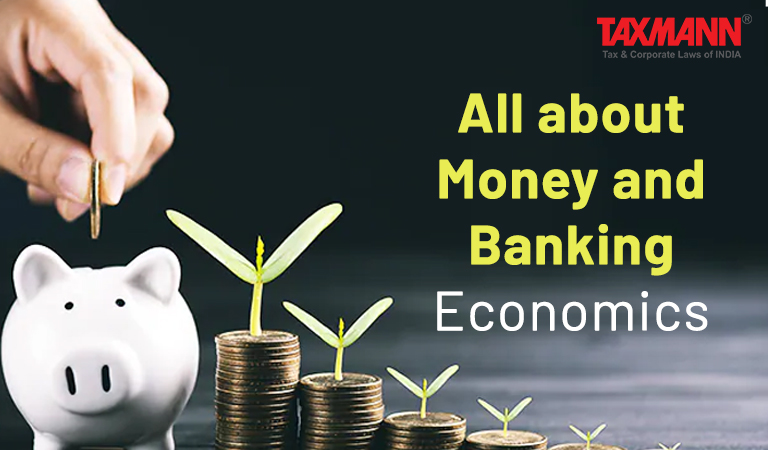All about Money and Banking | Economics
- Blog|FEMA & Banking|
- 2 Min Read
- By Taxmann
- |
- Last Updated on 22 September, 2022

Checkout Tan Print's Economics for NTA CUET (UG) 2022 which intends to cater to the principal needs of all the students preparing for the Common University Entrance Test (CUET) at the Undergraduate Level in the Economics Domain. This book contains the practice material in a highly student-friendly and thorough manner.
1. A Quick Review
-
- Money is a commodity accepted by general consent as a medium of economic exchange.
- Money is an economic unit that functions as a generally recognized medium of exchange for transactional purposes in an economy.
- A currency has to be derived from the Latin word “currere” which means “to run” or “to flow”.
- Money has been derived from the Roman word “monere” which means “to warn” in Latin.
- Digital currency (digital money, electronic money or electronic currency) is any currency, money, or money-like asset that is primarily managed, stored or exchanged on digital computer systems, especially over the internet.
- One well-known form of digital money is the cryptocurrency Bitcoin.
- Digital money can also represent fiat currencies, such as dollars or euros.
- Digital money is exchanged using technologies such as smartphones, credit cards, and online cryptocurrency exchanges.
- Reserve Bank is the Central Bank of India.
- RBI was nationalised in 1949.
- The Reserve Bank of India was established on April 1, 1935 in accordance with the provisions of the Reserve Bank of India Act, 1934.
- The Central Office of the Reserve Bank was initially established in Kolkata but was permanently moved to Mumbai in 1937. The Central Office is where the Governor sits and where policies are formulated.
- A commercial bank is a financial institution that accepts deposits, offers checking and savings account services, and makes loans.
- As of October 2020, there were 34 private and public banks licensed in India.
- The biggest public bank was the State Bank of India and the biggest private bank was the HDFC bank.
Disclaimer: The content/information published on the website is only for general information of the user and shall not be construed as legal advice. While the Taxmann has exercised reasonable efforts to ensure the veracity of information/content published, Taxmann shall be under no liability in any manner whatsoever for incorrect information, if any.

Taxmann Publications has a dedicated in-house Research & Editorial Team. This team consists of a team of Chartered Accountants, Company Secretaries, and Lawyers. This team works under the guidance and supervision of editor-in-chief Mr Rakesh Bhargava.
The Research and Editorial Team is responsible for developing reliable and accurate content for the readers. The team follows the six-sigma approach to achieve the benchmark of zero error in its publications and research platforms. The team ensures that the following publication guidelines are thoroughly followed while developing the content:
- The statutory material is obtained only from the authorized and reliable sources
- All the latest developments in the judicial and legislative fields are covered
- Prepare the analytical write-ups on current, controversial, and important issues to help the readers to understand the concept and its implications
- Every content published by Taxmann is complete, accurate and lucid
- All evidence-based statements are supported with proper reference to Section, Circular No., Notification No. or citations
- The golden rules of grammar, style and consistency are thoroughly followed
- Font and size that’s easy to read and remain consistent across all imprint and digital publications are applied



 CA | CS | CMA
CA | CS | CMA
